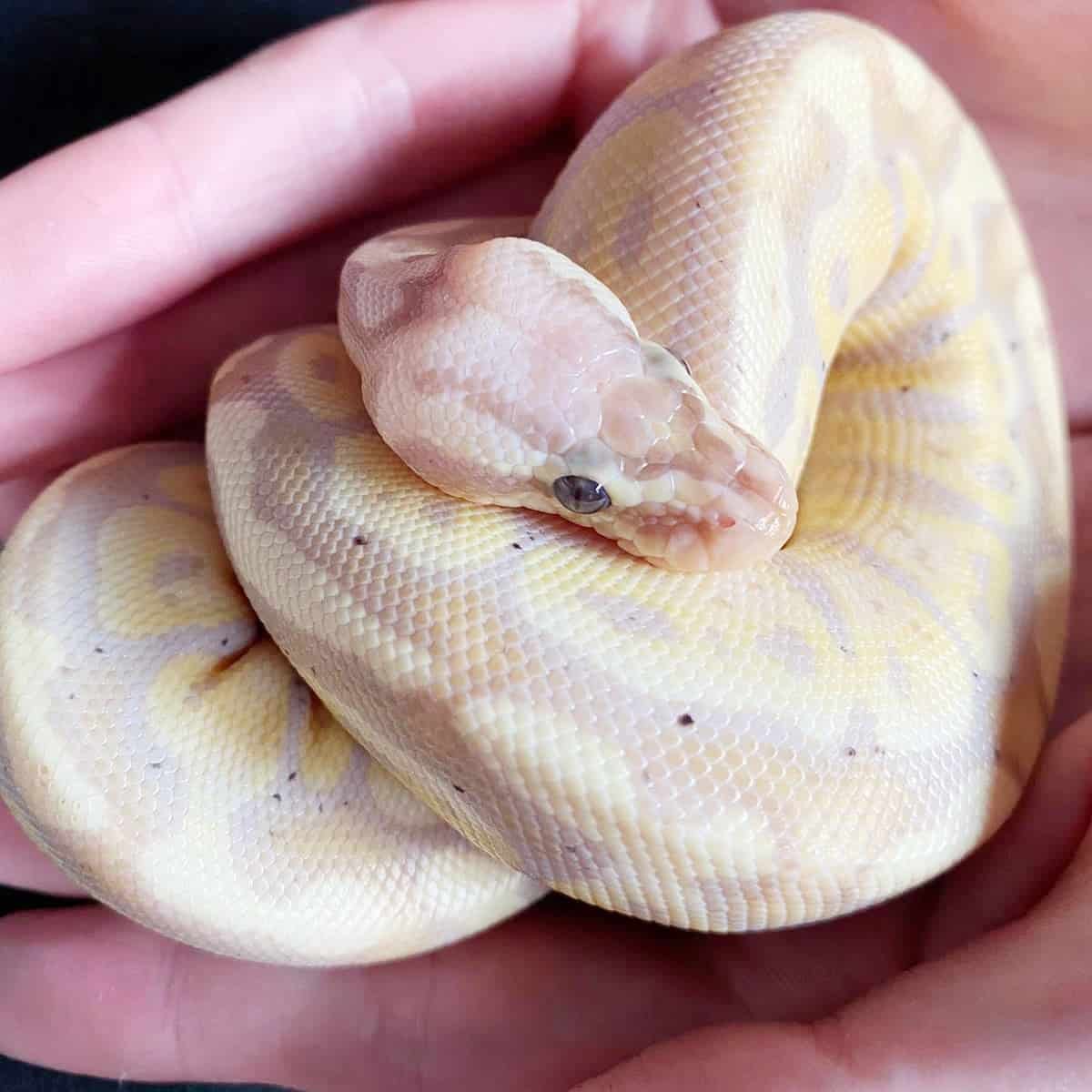Taming Reptiles, Why Bother With Consent?
Figure 1: Ball python (Python regius) showing tensed defensive balling behaviour, a clear indicator of discontent.
How do Keepers Typically View “Taming Reptiles”?
Traditionally there is an arbitrary culture for taming reptiles that consists of regular handling until our pets learn to accept our interactions. Signs that the reptiles are uncomfortable or frightened are ignored and with perseverance these reptiles learn to grow to accept and tolerate these sessions. Often new keepers search online for how to tame my pet snake or lizard, there are however issues with the practice in the sense that this involves an aspect called flooding.
What Is Flooding?
Forced handling often elicits one of the four F’s (fight, flight, fret or freeze) as a response such as biting, writhing, struggling, defecating, musking and freezing and other forms of reactions, all of these come from the animal being scared. Unsurprisingly this does not lead to an animal that enjoys interactions, it is incredibly damaging not only to your relationship with the animal, but their health and well being not only mentally, but physically. It is not taming reptiles in the way one might think. Stress has been shown to cause immunosuppression (Wilkinson, 2015). Repeated stressful events can prevent them from thriving and can lead to premature death.
Early on in comparative psychology it was believed that all animals, including reptiles and amphibians were instinctually bound and controlled machines which reacted and were controlled by external factors (Maier and Schneirla, 1935). There is a growing body of research which identifies reptiles as sentient beings who are able to experience feelings, both positive and negative (Lambert et al., 2019). This means that they have the ability to suffer under certain circumstances, this attitude change towards pet reptiles and their capacity for sentience has encouraged a movement away from exposing them to negative states.
There are many studies to show that there is an increased heart rate (tachycardia) in snakes and lizards in response to stress from what was determined as 1 minute of gentle handling both immediately during and up to ten minutes after, although there was no significant difference in the frogs (Cabanac and Cabanac, 2000). Reptiles also experience what is called ‘behavioural fever’, this is where after a stressful event a healthy, but stressed reptile will seek out higher than normal temperatures. After a handling session which, to the reptile, is interpreted as a capture and predation will cause individuals to seek out higher temperatures until they ‘settle’ (Warwick et al., 2013). Although it is important to provide these temperatures to allow reptiles to settle after even minor stress, it isn’t hard to see how this could lead to a reptile burning itself.
Choice Based Handling?
Figure 2: Notice the demeanor of this individual, a loosely coiled relaxed body posture.
Reptiles are entirely capable of positive experiences. There have also been many studies which showed that reptiles do and can participate in play. They are also capable of cognitive learning including Pavlovian and operant conditioning using positive reinforcement, many different species have been shown to be able to be target trained (Lori Torrini’s work with snakes is a great resource for this). Frogs have also been shown to be able to socially learn, starting from tadpoles lifestage (Ferrari and Chivers, 2008). Choice based, or consent based handling gives the reptiles control and therefore interactions come from a place of trust and strengthen keeper/owner relationships with reptiles. Rather than chasing a reptile around the enclosure and capturing it because of an antiquated view of taming reptiles.
The science of reptile welfare and cognition is still incredibly under studied, however it is important not to base our interpretation of welfare on misleading indicators that sellers, keepers and professionals commonly suggest such as ‘good feeders’, ‘good body weight’ or ‘active reproduction’, in isolation these are lacklustre indicators of positive welfare (Broom and Johnson, 1993, Warwick, 2004, Warwick et al., 2013).
Captivity-related chronic stress behaviour can lead to abnormal behaviours, behavioural inhibition, vigilance behaviour, fearfulness, hiding, increased frequency of negative behaviours such as startle, aggression and freezing behaviour and decrease in positive behaviours including exploratory, reproductive and in general behaviour complexity (Morgan and Thromborg, 2007).
Has It Tamed Down, or Shut Down?
Does you reptile stop trying to run away because it has ‘tamed down’, or because due to stress levels it is now freezing till the stressor has stopped? We have to be careful how we interpret behaviours and interactions.
References
Arena, P. C., Warwick, C. (2004) Miscellaneous factors. In Health and Welfare of Captive Reptiles. Eds C. Warwick, F. L. J. Frye, B. Murphy Chapman & Hall/Kluwer. pp 263- 283Morgan, K. N., Tromborg, C. T. (2007) Sources of stress in captivity. Applied Animal Behaviour Science 102, 262- 302
Broom, D., Johnson, K. G. (1993) Stress and Animal Welfare. Chapman and Hall/Kluwer. pp 80- 82
Burghardt, G. M. (2013). Environmental enrichment and cognitive complexity in reptiles and amphibians: Concepts, review, and implications for captive populations. Applied Animal Behaviour Science, 147(3-4), 286–298. https://doi.org/10.1016/j.applanim.2013.04.013
Cabanac, A., & Cabanac, M. (2000). Heart rate response to gentle handling of frog and lizard. Behavioural Processes, 52(2-3), 89–95. https://doi.org/10.1016/s0376-6357(00)00108-x
Ferrari, M. C. O., & Chivers, D. P. (2008). Cultural learning of predator recognition in mixed-species assemblages of frogs: The effect of tutor-to-observer ratio. Animal Behaviour, 75(6), 1921–1925. https://doi.org/10.1016/j.anbehav.2007.10.037
Lambert, H., Carder, G., & D’Cruze, N. (2019). Given The cold shoulder: A review of the scientific literature for evidence of reptile sentience. Animals, 9(10), 821. https://doi.org/10.3390/ani9100821
Warwick, C., Arena, P., Lindley, S., Jessop, M., & Steedman, C. (2013). Assessing reptile welfare using behavioural criteria. In Practice, 35(3), 123–131. https://doi.org/10.1136/inp.f1197
Whittaker, A. L., Golder-Dewar, B., Triggs, J. L., Sherwen, S. L., & McLelland, D. J. (2021). Identification of animal-based welfare indicators in captive reptiles: A delphi consultation survey. Animals, 11(7), 2010. https://doi.org/10.3390/ani11072010


